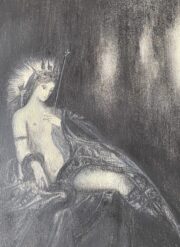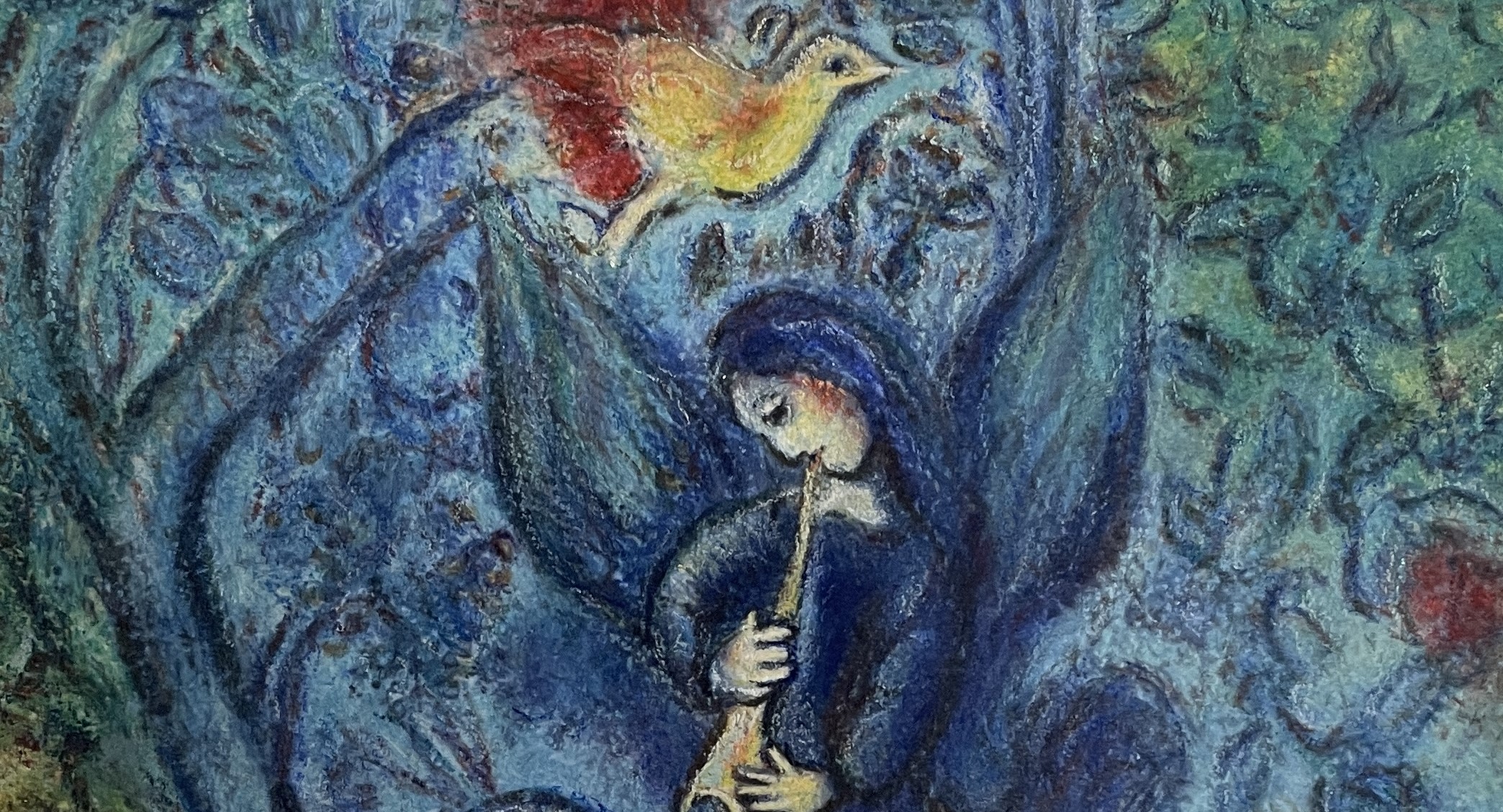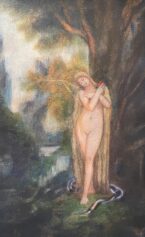日本語-Englishー台灣華語
ギュスターブ・モロー「サロメの舞踏」
建築家で芸術に造詣の深い父と音楽家の母との間に生まれたモローは、家族の温かい理解と経済的支援を得て、生涯売り絵をすることなく絵画の道を極めることができた。モローは、アングルの線とドラクロワの生気溢れる色彩を融合しようとしたシャセリオーの絵画世界を受け継いで、神秘的で装飾的な絵画を生み出してゆく。モローは自分の絵画世界をこんな風に語っている。「私は手に触れるもの、目に見えるものを信じない。目に見えないもの、ただ感じるものだけを信じている」と。こうして写実主義や印象主義をかたくなに拒否し、一度見たら忘れられない幻想的な独自の絵画世界を築きあげた。
絵画表現上の新しさを提示した印象派は、人間の内面を表現した象徴派の幻視的絵画に比較して過大に評価されているように私には感じられる。絵は外光の中の目に見えるものを描くばかりではなく、心に潜む目に見えないものを表現してこそ琴線に触れるものだ。確かに印象派の絵は心地よくいつ観ても美しいのだが、何度も観ていると思いのほか早く飽きてしまう。私の知り合いがルノアールの素晴らしい「花篭を持つ少女」と一緒に暮らし、そう言っていた。彼はその後モローの絵を大量に買い集めていたが、今はどうしているのだろう。以前彼の事務所でモローの絵をまとめて見せてもらったことがあるが、モローの絵は麻薬のように脳内に中毒物質を生成し、執着を生むのかもしれない。昔から日本人の心ある収集家は密かにモローの絵を買い集めている。印象派の絵によって人格は変革しないが、モローの絵には現実と絵画世界の境を取り払って、人生を侵食する魔力が潜んでいる。
モローの大きな油絵は緩慢でつまらないが、小さな絵にはモローの真髄が凝縮され、魔性の美を放っている。とりわけ水彩が魅力的だ。モローの美品はいずれも極端にサイズが小さく、全てを仔細に模写することは不可能だ。技法的には、残された未完成の絵画から推察すると、モローは最初に彩色を施し、後から線描で細かな装飾模様を書き起こし、更にそこに彩色を施すという手順で描いていたことが伺える。モローの絵には緻密でかつ計算された乱雑さがあり、それが宝石のような輝きを放っている。
モローは晩年自分だけの美術館に心血を注いでゆく。彼は自分の中に渦巻く幻想的イメージに取り囲まれて永遠に暮らしたかったのだ。現世との煩わしい関わり合いを離れて生み出されるモローの絵画世界は、異質の美を排除した完結空間にあってこそ理解されるものなのである。モローが晩年美術教師を引きうけたのは、精神的バランスを維持するための彼なりの対処法だったと思う。モローがルオーやマティスを見出したことは、はじめは意外であったが、ルオーはモローと精神的に同類であり、モローと一見対極にある単純な色彩を目指したマティスは、自らの絵画世界に囲まれた生活空間以外は実は許容できないというモローの本心と共通している。
この絵は、メナード美術館が所蔵する「サロメの舞踏」のサロメの部分だけを描いたものである。この作品はサロンに出品された有名な油彩の「ヘロデ王の前で踊るサロメ」を水彩で描いたものであるが、即興的要素の強い水彩の方が作者の真意が伝わってくる。モローは「ヘロデ王の前で踊るサロメ」を制作するに当たって、明暗効果を見るために鉛筆習作を多数制作しているので、私はそれに習って鉛筆で描いてみることにした。このサロメは、いくつか有名なサロメのポーズがある中で、最も優美な姿であると私は思う。少し仰け反った上半身が、前に踏み出そうとする全体の姿勢と均衡して、一瞬の静寂を生み出している。手足の先端に力がこもっているのが印象的である。わずか数ミリの表情の中に、念力が込められているのを描き分けるのが難しい。
サロメにはモローが目指した絵画芸術の真髄が集約して示されている。サロメは様々な画家によって繰り返し描かれているが、ついぞモローを超えるイメージを提示した画家はいない。モローがとりわけサロメにのめり込んで行ったのは、サロメが男の人生を狂わせる運命の女だからである。モローは若い頃、とある女性の性的魅力に幻惑され子をはらませてしまい、危うく人生を踏み外しかかる。彼は現実の女性の好みについては案外ノーマルだったと私は思うが、モローのサロメには、女性を神秘の対象として崇拝しながらも、魔性の性に溺れ、破滅に陥る畏敬の念が現れている。それでも画家は運命の女性を求めずにはいられない。たとえ人生が狂わされたとしても。

Goddess on the Rock
岩石上的女神
Salome’s dance
Born to a father who was an architect deeply versed in art and a musician mother, Moreau was able to dedicate his life to painting without ever having to sell his work, thanks to his family’s warm understanding and financial support. Moreau inherited the pictorial world of Chassériau, who sought to merge Ingres’s lines with Delacroix’s vibrant colors, and went on to create mystical and decorative paintings. Moreau described his artistic world as follows: “I do not believe in what I touch or what I see. I only believe in what I cannot see and what I feel.” Thus, he steadfastly rejected realism and impressionism, building a unique and unforgettable fantastical world of his own.
To me, Impressionism, which presented a novelty in painting expression, seems to be overvalued compared to the visionary paintings of Symbolism, which expressed the human psyche. Art is not only about depicting what is visible in the external light but also about expressing the invisible that lurks in the heart, which truly resonates. Although Impressionist paintings are indeed pleasant and beautiful at any viewing, I find myself quickly growing tired of them after repeated viewings. An acquaintance of mine who lived with Renoir’s wonderful “Girl with a Basket of Flowers” said the same. He later collected a large number of Moreau’s paintings, and I wonder what he is doing now. I once had the opportunity to see a collection of Moreau’s paintings in his office, and it might be that Moreau’s paintings produce a drug-like effect, generating addictive substances in the brain and fostering an obsession. For a long time, discerning Japanese collectors have been secretly amassing Moreau’s works. While Impressionist paintings do not transform one’s personality, Moreau’s paintings possess a magical power that erodes the boundary between reality and the painted world, invading life itself.
Moreau’s large oil paintings may seem slow and uninteresting, but his smaller works encapsulate the essence of Moreau, exuding a demonic beauty, particularly his watercolors. Moreau’s masterpieces are all extremely small in size, making it impossible to replicate every detail. Technically, from his remaining unfinished paintings, it can be inferred that Moreau first applied color, then detailed decorative patterns with line drawing, and finally added more color. Moreau’s paintings exhibit a meticulous yet calculated disorder, shining like gems.
In his later years, Moreau devoted himself to his own museum, wanting to live forever surrounded by the fantastical images swirling within him. The world of Moreau’s paintings, created away from the bothersome interactions with the real world, can only be understood in a complete space devoid of foreign beauty. Taking on the role of an art teacher in his later years was, I believe, his way of maintaining mental balance. The fact that Moreau discovered Rouault and Matisse was initially surprising; however, Rouault was spiritually akin to Moreau, and Matisse, who sought simple colors seemingly at the opposite spectrum, actually shared Moreau’s deep conviction of not tolerating anything outside his own painted living space.
This painting is a watercolor version of “The Dance of Salome” owned by the Menard Art Museum, focusing solely on Salome from the famous oil painting “Salome Dancing before Herod.” The watercolor, with its improvisational elements, conveys the author’s true intentions more effectively. In preparing to create “Salome Dancing before Herod,” Moreau produced many pencil sketches to study the effects of light and shadow, which inspired me to try drawing in pencil as well. This Salome, I believe, is in the most graceful pose among the various famous depictions, with her slightly reclined upper body balancing the overall forward-moving posture, creating a moment of silence. The tension in the tips of her fingers is striking. It is challenging to capture the concentration of mental energy in just a few millimeters of expression. In Salome, the essence of the art of painting that Moreau aimed for is concentrated. Although many artists have repeatedly depicted Salome, none have surpassed Moreau’s image. Moreau’s deep fascination with Salome was because she was a woman destined to drive men’s lives to madness. In his youth, Moreau was bewitched by the sexual allure of a woman, leading to an unplanned pregnancy, nearly derailing his life. I think Moreau was surprisingly normal in his taste for real women, but his Salome embodies the reverence and dread for the demonic nature of femininity, worshipped as a mystical object yet leading to ruin. Yet, the artist could not resist seeking the woman of fate, even if it meant his life was thrown into disarray.
古斯塔夫·莫羅《莎樂美之舞》
出生於一位對藝術有深入了解的建築師父親和音樂家母親之間的莫羅,在家庭的溫暖理解和經濟支持下,得以終生不需通過賣畫維生,極致地追求繪畫之路。莫羅繼承了沙塞里歐試圖融合安格爾的線條與德拉克洛瓦生動色彩的畫風,創造出神秘且裝飾性的畫作。莫羅這樣描述自己的繪畫世界:“我不相信手可觸及之物、眼可見之物。我僅信仰眼不可見、僅可感覺之物。”因此,他堅決拒絕了寫實主義和印象主義,建立了一個一旦目睹就難以忘懷的獨特幻想畫境。
相較於展現畫面新穎的印象派,我認為表達人內心世界的象徵派幻想畫作被過度高估。畫作不應僅描繪外在光影中可見之物,更應表現潛藏於心的看不見之物,這樣才能觸動人心。印象派的畫確實觀賞起來令人愉悅,總是美麗的,但多看幾次後會意外地快速感到厭倦。我的一位朋友曾與雷諾瓦的《手持花籃的少女》同住,並這樣說過。後來,他收藏了大量莫羅的畫作,不知他現在怎樣了。我曾在他的辦公室一次性看過莫羅的多幅畫作,莫羅的畫作或許像鴉片一樣,在腦內產生了依賴性物質,引發了執著。長久以來,懷有情感的日本收藏家們一直秘密地收集莫羅的畫作。印象派的畫作雖然不會改變人的性格,但莫羅的畫作卻隱藏著魔力,能消融現實與畫境的界限,侵蝕人生。
莫羅的大型油畫雖然緩慢且乏味,但小幅作品則凝縮了莫羅的精髓,散發出魔性之美。尤其是水彩作品極具魅力。莫羅的精品作品無一例外尺寸極小,不可能全部細致複製。從技法上看,從留下的未完成畫作中可以推測,莫羅是先上色,然後用線條勾勒細緻的裝飾圖案,再進行上色。莫羅的畫作擁有精緻而計算中的混亂美,散發著寶石般的光芒。
莫羅晚年將心血投入到自己的美術館。他希望永遠生活在自己幻想的形象之中,遠離現實世界的煩擾。莫羅的畫作世界是在一個排除異質美的完整空間中才能被理解的。莫羅晚年成為美術教師,我認為這是他維持精神平衡的方式。莫羅發掘了魯奧和馬蒂斯,起初令人意外,但魯奧與莫羅在精神上是同類的,而馬蒂斯追求的簡單色彩,實際上與莫羅只能在自己的畫境生活空間中找到寬容的真心相通。
這幅畫是梅納德美術館收藏的《莎樂美之舞》,只描繪了莎樂美部分。這件作品是以水彩畫出的,基於沙龍展出的著名油畫《在希律王前跳舞的莎樂美》,但水彩的即興元素更能傳達作者的真意。莫羅在創作《在希律王前跳舞的莎樂美》時,為了觀察明暗效果製作了許多鉛筆草圖,因此我決定嘗試用鉛筆畫。我認為這個莎樂美姿態是最優雅的之一,稍微仰頭的上半身與前進姿態的整體平衡,創造了一瞬間的靜謐。手足的力度尤為印象深刻。在幾毫米的表情中分辨出心念是困難的。莎樂美集中了莫羅所追求的繪畫藝術的精髓。儘管許多畫家重複描繪莎樂美,但沒有人能超越莫羅提出的形象。莫羅對莎樂美的著迷,是因為莎樂美是命運之女,能讓男人生活陷入瘋狂。莫羅年輕時曾被一名女性的性吸引所迷惑,差點偏離人生軌道。我認為他對現實女性的喜好相當正常,但莫羅的莎樂美展現了一種對女性的神秘崇拜,同時沉溺於其魔性,陷入毀滅的畏懼。然而,畫家仍無法抗拒尋求命運之女,即使這意味著人生可能會被扭曲。



